Discrete Element Simulation in MotionSolve
A Discrete Element Method (DEM) is a numerical method that computes the motion and effect of a large number of small particles.
It is commonly used to model the bulk behavior of granular materials. The method assumes that the material consists of separate, discrete particles. These particles may have different shapes and properties.
- Bulk materials in storage silos, like cereal
- Granular matter, like sand or sand
- Powders, like toner
- Blocky or jointed rock masses
- Inter-particle contacts with friction
- The force of attraction between particles due to their mass (often small enough to neglect)
- Attractive potentials, such as cohesion, adhesion, liquid bridging and electrostatic attraction
- Electrostatic Coulomb forces
- The van der Waals force between molecules
How does MotionSolve perform DEM simulations?
MotionSolve performs co-simulation with a well-known DEM solution, EDEM, to provide a comprehensive solution for such scenarios.
- MotionSolve models the system interacting with the bulk material. This could be, for example, an earth moving machinery or an ATV going over a sandy terrain.
- EDEM models the bulk material.
- The interaction between the interacting system and the bulk material is handled via co-simulation.
- MotionSolve and EDEM run in separate processes. They can run in the same or different machines.
- TCP/IP is used as the communication methodology when MotionSolve and EDEM run in two different machines.
- A named PIPE is used as the communication methodology when MotionSolve and EDEM run in the same machine.
This basic structure of the interaction is shown in the figure below.

Figure 1. Co-simulation between MotionSolve and EDEM
What is the EDEM?
- Simulate any material
- Comprehensive range of validated physics models available that allows users to simulate any material type and shape, such as large lumps and dry, fine, sticky, cohesive, and flexible elements.
- Easy workflow
- Intuitive user interface for quick simulation set-up, advanced visualization and analysis.
- High Performance
- Fast and scalable compute performance across CPU, GPU, and multi-GPU solvers to simulate large and complex particle systems.
- Material models
- Instant access to a library of thousands of pre-calibrated material models representing rocks, soils, ores and powders through its GEMM database.
- Advanced customization
- Custom physics through its Applications Programming Interface for complex simulations and advanced material behavior; for instance, to simulate sticky solids, breakage and flexible fibers.
The figure below illustrates a typical simulation that EDEM can perform.

Figure 2. Dump-truck unloading coal into a hopper .
The Value of Discrete Element Simulation in MotionSolve
- Design systems that include complex interactions with bulk material
- Accurately predict forces acting on equipment interacting with bulk materials
- Predict component durability using the computed forces
- Identify excessive wear zones on equipment
- Optimize material distribution and detect “dead zones”
- Quantify system power requirements
The figure below illustrates how particle sizes can affect the loads on the dump truck in figure.
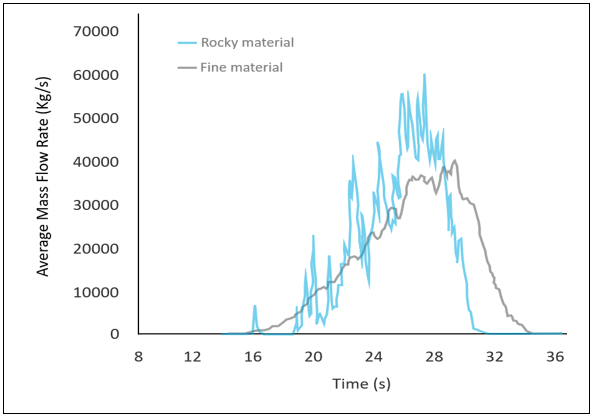
Figure 3. The effect of particle size on the forces acting on the dump truck
Applications of Discrete Element Simulation in MotionSolve
MotionSolve, together with the EDEM, can be used in a variety of industries for a variety of applications. In the following, four different applications and diverse industry are presented.
Operational Behavior of Heavy Equipment
- Dump truck bodies
- Excavators and Diggers
- Grab Buckets
- And others
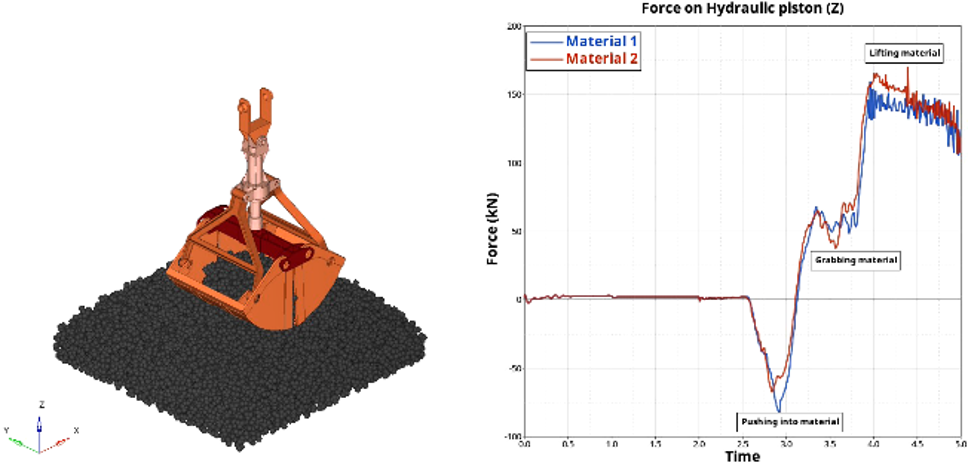
Figure 4. A grab bucket picking up coal from a pile
Mining and Construction
- Transfer chutes
- Bucket conveyor systems

Figure 5. Various material handling equipment handling bulk material
Agricultural Machinery
- Combine harvesters
- Feeders
- Tractors and tillage equipment
- Tire – soil interaction
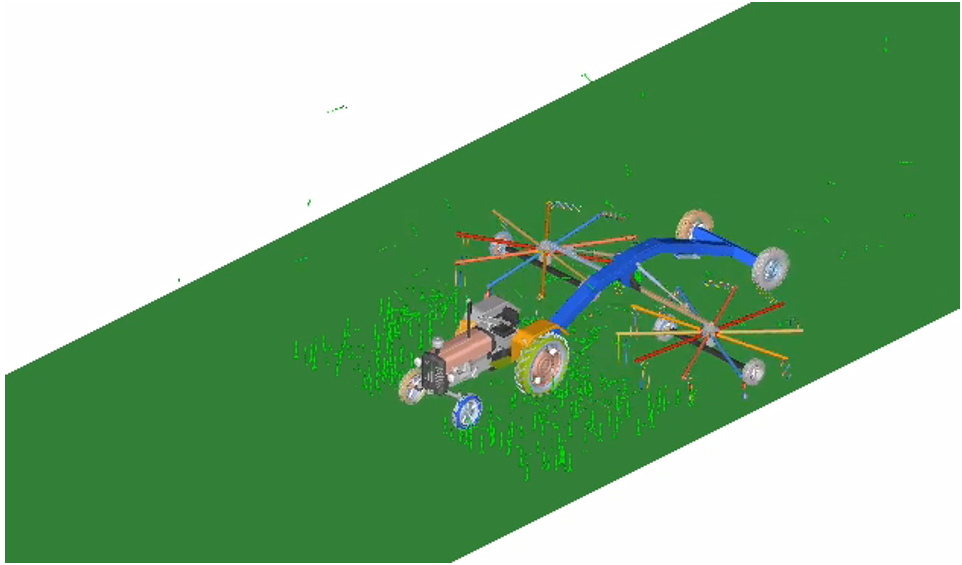
Figure 6. A liner harvesting crop
Pharmaceuticals and Chemicals
- Hopper discharge with bridge breakers
- Powder raking and spreading
- Wet mixing of aggregate fractions
- Dry mixing of aggregate fractions
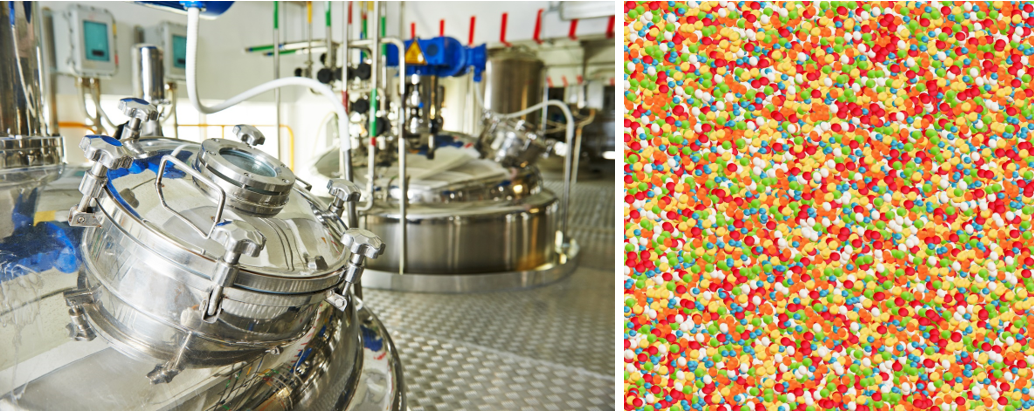
Figure 7. Bulk material simulation in the pharmaceutical and chemical industry
The Data Flow Between MotionSolve and EDEM
- The EDEM solution is wrapped in a Functional Mock-Up Unit (FMU) of type co-simulation using the FMI protocol.
- MotionView imports one or more instances of the EDEM FMU into a MotionSolve system model.
- The MotionSolve system model communicates to the EDEM FMU at run time.
- At each point in time, MotionSolve tells EDEM where the system is and how fast it is moving.
- In response, EDEM returns the forces exerted by the bulk material on the various bodies that interact with the bulk material.
- Since only rigid bodies are supported at this time, EDEM sums all the particle forces and torques acting on each body and returns the net force and torque acting at the center of mass coordinate system of each interacting body.
The connections between EDEM, MotionView and MotionSolve are shown in the image below.
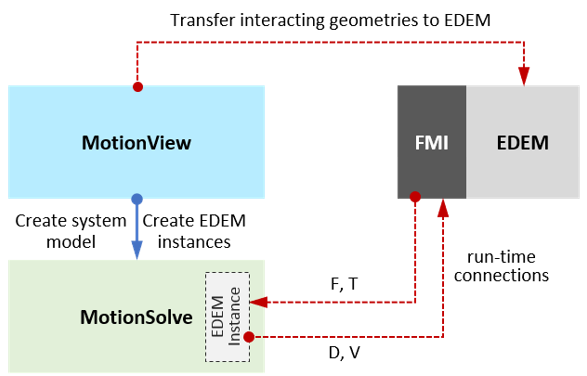
Figure 8. The data flow between EDEM, MotionView and MotionSolve
The MotionSolve-EDEM Co-simulation Process
Solution Overview
- Build a system model in MotionView that includes a bulk material model in EDEM.
- Launch the combined simulation from MotionView.
- Post process the results entirely in HyperView.
MotionSolve – EDEM interaction
- Each interacting body in MotionSolve may be described by arbitrarily complex CAD graphics. These are sent to EDEM, so you need not tell EDEM what the interacting geometries are.
- You can leverage all bulk material capabilities of EDEM such as different bulk material models including user defined ones, bonding, and, friction between bulk particles.
- At each point in time, MotionSolve sends body location and velocity to EDEM.
- EDEM computes the net force and moment applied by the bulk material on each body.
Model Build, Analysis, and Review
An EDEM license is required to run the simulation. EDEM is not supported by the HyperWorks Units (HWU). Please contact an Altair representative to acquire a EDEM license, if you don’t have it. Use the Discrete Element Method tool in MotionView to set up and run a MotionSolve + EDEM co-simulation. The tutorial MV-7021: MotionSolve/EDEM Co-Simulation explains in detail how the MotionSolve + EDEM co-simulation is to be performed.
Limitations
- Co-simulation is only supported on the Windows 64 platform. Linux 64 is not yet supported.
- A maximum of 1,024 rigid bodies in MotionSolve can be in contact with the particles defined in EDEM.
- Flexible bodies in MotionSolve cannot interact with particles in EDEM.
- Save/Load in MotionSolve, in conjunction with corresponding
operations in EDEM, is not supported
- Quasi-static and Linear analysis are not support with this connection
- On Windows, if Microsoft Visual C++ 2010 SP1 Redistributable Package (x64) is not available, then the co-simulation will fail with an error "Failed to load edem.dll"
Conclusion
MotionSolve provides an intuitive, yet powerful, approach for system level simulations that include bulk materials. EDEM is used as the solution for the particle level simulation. MotionSolve performs the system level simulation. A co-simulation approach using FMI/FMU protocols connects the two simulations. HyperView can be used to view the combined results.